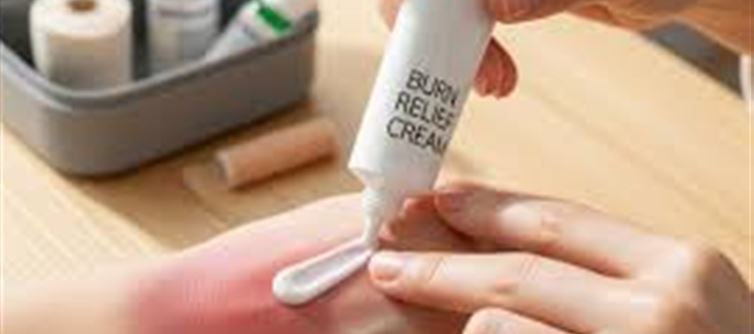
Burn injuries are one of the most common mishaps we face in daily life, whether it’s from hot oil splashing in the kitchen, touching a heated surface, or enduring a painful sunburn. It’s essential to know how to handle burns correctly to avoid further complications and aid in faster recovery.
Here’s a guide to burn care for different types of burns you may encounter in everyday life:
1. Kitchen Burns: Handling Hot oil and Boiling Liquids
Common Causes:
· Splash of hot oil while cooking or frying.
· Boiling water or liquid splashes.
First Aid:
1. Cool the Burn:
o Immediately run cool (not cold) water over the affected area for 10–15 minutes. This helps lower the skin temperature and reduces pain.
o Cold compresses can also be applied if running water isn’t an option.
2. Avoid Ice:
o Never apply ice directly on the burn as it can cause more damage to the tissue.
3. Clean and Protect:
o Gently clean the burn with mild soap and water.
o Apply a burn ointment or antibiotic cream (like Neosporin) to prevent infection.
4. Cover the Area:
o Cover the burn with a sterile bandage or gauze pad to protect it from further irritation.
5. Pain Relief:
o If the pain persists, consider over-the-counter pain relievers such as ibuprofen or acetaminophen.
2. Sunburns: Protecting Your Skin from Harmful UV Rays
Common Causes:
· Spending too much time in the sun without protection.
· Exposing sensitive areas (like the face and shoulders) for extended periods.
First Aid:
1. Cool the Skin:
o Use cool (not cold) water to gently shower or soak the sunburned area. This will provide relief and reduce inflammation.
o Cold compresses are also effective for localized areas of sunburn.
2. Moisturize:
o After cooling the skin, apply an aloe vera gel or moisturizing lotion containing vitamin E to keep the skin hydrated and promote healing.
3. Stay Hydrated:
o Sunburns can lead to dehydration, so it’s essential to drink plenty of water.
4. Avoid Scratching:
o Don’t scratch or peel the skin as this can increase the risk of infection and cause scarring.
5. Pain Relief:
o For moderate pain, you can take over-the-counter pain relievers.
o Hydrocortisone cream can help reduce inflammation in some cases.
3. Burns from Hot Surfaces (Like Stovetops and Irons)
Common Causes:
· Touching hot pots, pans, or irons.
· Accidental burns from heated metal surfaces.
First Aid:
1. Cool the Burn:
o Immediately place the affected area under cool running water for at least 10 minutes.
2. Protect the Burn:
o After cooling, apply an antiseptic ointment or burn cream.
3. Cover the Burn:
o Cover the burn with sterile gauze to prevent infection and keep the area protected.
4. Seek Medical Help:
o For severe burns, such as blisters or large burns, seek medical attention immediately.
4. Chemical Burns: Quick Care for Skin Exposure to Harsh Substances
Common Causes:
· Exposure to cleaning chemicals, acids, or alkalis.
First Aid:
1. Rinse Immediately:
o Rinse the area under water for 15–20 minutes to dilute the chemical and flush it away.
2. Remove Contaminated Clothing:
o Take off any clothing or jewelry that has come into contact with the chemical.
3. Seek Medical Attention:
o For severe chemical burns, immediate medical attention is crucial. Call an emergency service if necessary.
5. Electrical Burns: When the Skin Comes in Contact with Electric Current
Common Causes:
· Touching exposed wires, electric shocks, or electrical appliances.
First Aid:
1. Turn Off the Source of Electricity:
o If someone has been electrocuted, immediately turn off the power source before touching them to prevent further harm.
2. Call Emergency Services:
o Seek medical help immediately. Electrical burns can cause internal injuries, so it’s important to consult a doctor, even if the burn appears mild.
General Tips for Burn Care:
1. Avoid home Remedies:
o Stay away from applying butter, toothpaste, or oil on burns, as these can trap heat and cause further irritation.
2. Monitor for Infections:
o watch for signs of infection, such as redness, swelling, pus, or increased pain. If any of these occur, seek medical attention.
3. Know When to Seek Medical Help:
o Burns that cover a large area of the body or cause deep tissue damage require immediate medical care.
o Blisters that form or burns to sensitive areas like the face, hands, or genitals need medical attention.
Conclusion:
Burn injuries are common, but knowing the proper steps for treatment can make a huge difference in preventing complications. Whether it's a kitchen burn, sunburn, or an electrical shock, immediate and proper care is essential for quick healing and to reduce scarring. Always remember to stay calm, follow the first aid steps, and seek medical help when necessary.
Disclaimer:
The views and opinions expressed in this article are those of the author and do not necessarily reflect the official policy or position of any agency, organization, employer, or company. All information provided is for general informational purposes only. While every effort has been made to ensure accuracy, we make no representations or warranties of any kind, express or implied, about the completeness, reliability, or suitability of the information contained herein. Readers are advised to verify facts and seek professional advice where necessary. Any reliance placed on such information is strictly at the reader’s own risk..jpg)




 click and follow Indiaherald WhatsApp channel
click and follow Indiaherald WhatsApp channel